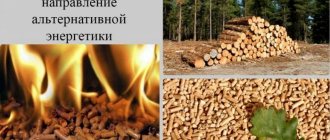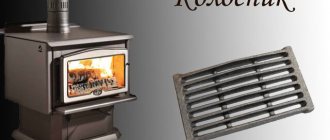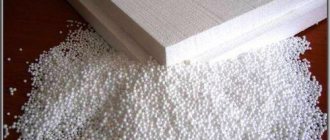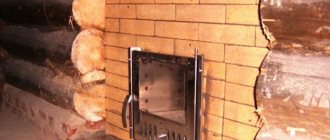Chopping wood options
You need to understand the difference between the processes of splitting and chopping wood. Splitting is to split a block or log into large fragments using a splitter. Chopping is cutting into smaller pieces, chopping off knots, chopping thin trees. Usually they chop thin logs, divide them with an ax into chips and splinters.
There are only two options for chopping firewood, either with the use of special equipment or without it.
Mechanical method
This method involves the use of equipment. The best option is an electric conical screw splitter. A rotating steel threaded cone is placed on the table top, which splits the block supplied to it. The hydraulic splitter works in the same way, but the splitting is done under the influence of the jack.
Both devices are quite dangerous to use. It is better not to use it without experience and first learn how to work with the mechanism.
Manual way
This method involves chopping wood with a cleaver or an ax on a prepared block.
As they say, the rich they are, so they are happy
There is an abandoned piece of land next to our site in the village, there are already many wild growth and old fruit trees on it. Fruit trees need pruning and care to keep them from running wild. We also have such trees in the garden.
Every autumn I do a pruning, in the spring it is necessary. A decent bunch is being gathered, not enough, of course, to be heated all winter, but enough for kindling.
A large deciduous tree, ash-leaved maple, has fallen this year. Oh .. and I had to tinker with it so that it fell normally and the saw did not break.
One stump cut off did not hold, it rolled into a ravine, rolled to our river and swam away! It was no longer possible to take it out. The rest were raised from the ravine, there was an assistant wife.

A lot of chicks turned out now need to be chopped and put into a pile - like a woodcutter to dry. Now it is raw firewood, but by next winter it will be as it should, ready for a bright burning. But without tar soot and soot in the pipe
.
Such raw blanks are poorly pricked, the wood structure is viscous, and even worse in the knots.
Why do they collect firewood in winter? In the forest, the plants sleep, the ground freezes, the equipment does not get stuck in the mud of the forest road and between the trees. The key word is freeze.
Trees also freeze, sap in them, moisture begins to turn into ice, and it, as you know, expands and breaks fibrous bonds, especially in sawn stumps.
Here's my advice, split the raw firewood you brought when the frost hits. It is easier to breathe in the open air with frost and work is a joy.


We proceed to splitting the sawn blanks, we will chop chocks. Now, of course, mechanisms are used in the industrial preparation of firewood. Human laziness drives civilization.
They invented mechanisms for splitting firewood based on hydraulics and electric motors. BUT! The main executive tool is a wedge. Ax.
There are many types of axes, with different sharpening, a handle with a bend, modern hatchets with a plastic handle, with centering, just lift it up - it will split itself.
What is needed for wood splitting?
To cut firewood correctly, you need to have the appropriate tool.
- Deck.
This is a thick saw cut from a tree, set vertically. The deck must be at least half a meter high and large enough in diameter. The gnarier the deck, the stronger it will be. A couple of knots should be left outside, which will serve as dragging handles.
The stump for the log is best taken from oak or elm.If there are none, you can use thick birch, but such a deck will last less.
Oak logs last about 8 years. To prevent the deck itself from splitting from blows, it is reinforced with a metal strip or chain.
- Ax or cleaver
An ax with a sharp blade is needed for cutting thin logs, removing knots, and preparing chips. Cleavers are different. A heavy cleaver with a blunt blade wedges thick blocks of wood, dividing them into pieces. Lightweight cleavers have the shape of a sharpened wedge blade or classic.
The cleaver must be chosen correctly. Of course, the handle should be comfortable and fit the width of your palm. Weight is also selected "for yourself" taking into account the fact that you have to do the swing. The handle should be birch, the hand rests well on it. Plastic or metal will slide. There are rubberized handles, they are comfortable, but they are usually found on expensive instruments.
- Wedges.
May be useful for splitting hard, thick tree cuts. Applied in addition to the cleaver, with which the block is made. A wedge is inserted into the crack formed. Hammered with a sledgehammer to split the log. Wedges can be smooth or serrated.
Preparatory stage of cutting firewood
The preparatory stage involves sawing trees manually or mechanically. Better to use a chainsaw. You can saw it by hand, then you need goats in which the log is placed. It is faster to work together, but you can act alone.
The sawn tree is pricked into logs, which must be 20% shorter in height than the length of the fuel compartment of the boiler or stove. The bark can be left on for now. Separate the knots with the same saw or ax.


Preparatory stage
It is recommended to dry the tree, that is, it is not immediately possible to chop the tree. Cutting fresh wood is not easy, the tool gets bogged down in raw wood. If the work is carried out in the winter, it is necessary to let the logs freeze well, then it will be easier to chop them.
Then the equipment and the area for work are prepared. The deck is placed on a flat area near the sawn logs and starts to work.
Mechanical wood splitters
The specialization of these machines is the splitting of small chocks (up to 50 centimeters). Manufacturers recommend using similar models to owners of wood-burning fireplaces. The mechanical unit does an excellent job of splitting even small pieces of wood. The resulting small lumps are used for kindling the fireplace.
The mechanism itself must be installed on a flat surface. To put it into operation, you need to raise the handle and put the log between the cleaver and the stop.
At the bottom there is a swinging frame. It is pressed until the workpiece cracks. Similar machines are available on the market in vertical and horizontal models.
Equipment
When chopping wood, the right equipment is just as important as the tools.
For work, you need to prepare protective accessories:
- Gloves. They should fit the hand well and not slip on the handle. Better to take cloth with a rubberized handheld or old leather. It is not recommended to use gloves, as they can fall off the hand. If the handle of the ax slips out along with the mitten, it can end sadly.
- Safety glasses, half mask. The glasses must be clean (not scratched or dirty), this will reduce the accuracy of the impact.
- Comfortable shoes or boots.
- Clothes can be any, but not open or very wide. Nothing should accidentally fall under the ax or interfere with the power of the swing.
Tips:
- You need to look under your feet so as not to stumble or slip, and you also need to take into account everyone around you.
- Choose the right ax for the job. Know when to use a narrow blade, wide blade, cleaver, splitting wedge, etc.
- Learn from an experienced lumberjack or woodcutter.
- You should never stand behind someone who chops wood with an ax.
- Let the ax do the job.This means moving quickly, clearly, and then weakening the strike, just before the ax digs into the tree. At the last moment, you are only guiding the ax. This prevents excessive force from being applied and the shock from the impact is transmitted to the muscles. This way you will be able to chop much longer.
- Work with a sharp tool. A blunt ax can slip off the block without splitting it, or has a greater risk of injury than a sharp ax. If you don't know how to sharpen an ax, ask someone.
- When you chop wood with an ax, strike with the ax not in the center of the block, but slightly displace the perpendicular - so there is less chance that the ax gets stuck in the block and helps to split the block more easily.
Warnings:
- Do not place your hand or fingers on the top of the block you want to split in order to hold it or straighten it at the last moment. When it is necessary to chop a splinter for kindling, smaller logs are often placed on the deck, holding them on one side and, when splitting with an ax, on the other side. This can cause serious injury to the fingers or be chopped off. The likelihood of an accident will be much lower if you use work gloves when chopping wood or splinters.
- Never stand behind or too close to anyone using an ax.
- Wear gloves, boots or boots and safety glasses.
- Do not use a blunt or damaged ax. Before using the ax, you should always inspect the blade and the ax and the reliability of the attachment of the ax to the ax.
- If you have back problems, do not try to chop wood until you are absolutely sure that you can physically do it.
- Stand with your feet shoulder-width apart if you want to chop in the middle - if the log bounces back and you miss, there is less chance of injury to your leg.
Wood splitting technique
Compliance with the technique of splitting firewood manually and mechanically will allow you to work without unnecessary labor costs.
By hand
Large blocks of wood are cut with a cleaver. It has a dull blade that makes a split.
How to chop wood with a cleaver:
- Place the block on the deck by shifting it to the opposite edge of the base.
- Select the largest crack on the cut and hit it with a cleaver.
- For a smooth cut, select a knot-free area for the blow.
- If the cleaver is stuck, you need to hit the butt with a sledgehammer or drive a wedge nearby.
- Continue to divide the split block into smaller parts.
- If the saw cut is too thick, it is better to start splitting from the edges, reducing its diameter.
How to chop wood with an ax:
- You can chop small logs by placing them vertically on the deck.
- The log, divided in half, is again placed vertically and, with an accurate blow of the ax, is split into quarters.
- They cut off the bark from the logs with an ax. The bark can be cut into small strips and used for ignition.
- You can continue to cut the log into chips. Wood chips are also good for ignition.
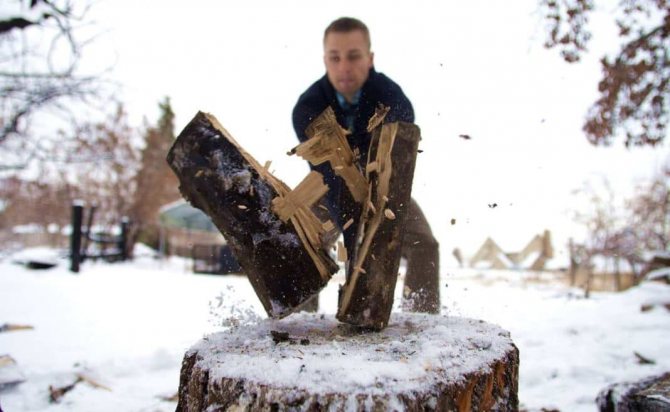

When chopping wood, legs should be shoulder-width apart
When chopping wood, technique is important. How to cut firewood correctly:
- Legs should be shoulder-width apart. This is essential for better support and safety. If the ax breaks free from the hands, it will not fall on the leg.
- Get up from the deck at arm's length. The end of the ax should touch the edge of the deck.
- Grip the handle firmly with both hands and lift it to a sufficient height. You do not need to lift the tool high, otherwise the impact force will decrease.
- The blow must be sharp, you must use your own gravity and the force of the cleaver.
Mechanically
The steps are very simple. Place the deck on the screw cleaver platform close to the cone. Switch on the unit. Holding the block from above, move it onto a cone, which will screw into the tree and split it. Repeat the operation by turning the log 90 degrees.


Mechanical way of chopping firewood
When using a hydraulic jack, the block is brought under the cutting head. The chopped log is put there again and so on to the desired size.
How to chop wood with an ax
1. Prepare yourself. In addition to the fact that you need logs cut in lengths of 40-50 cm (or, approximately, the length of the forearm) and your trusty ax, you should also have personal protective equipment:
- Work gloves.
- Work boots.
- Safety glasses (optional, but recommended).
2. Find and install the deckon which you will prick
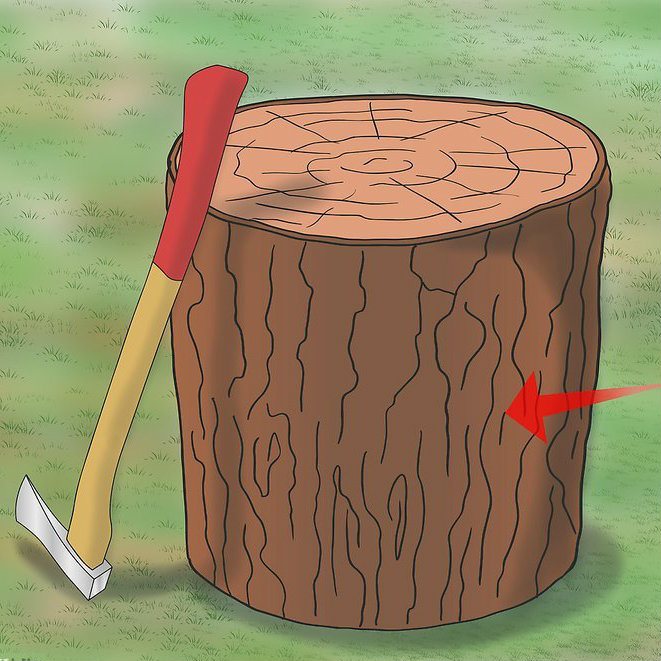

firewood. If you do not have such a deck, then you need to choose a large, thick, gnarled part of the trunk of a hard tree. The bottom butt of a hard tree trunk will also make an excellent log.
- If you choose a deck, look for the knobby part of the wood as it is harder to split and will last longer as a deck.
- If it is possible to use viscous wood for a log, it is necessary to take advantage of this, since the natural structure of such wood will ensure the strength and durability of the log.
- Pulling an old tire over the top of the deck will prevent the edges of the deck from chipping.
- The deck for chopping wood must be stable and have a flat working surface so as not to beat the hatchet, and the ax does not slip and does not miss, so as not to be injured.
3. Install the block. Take one of the chopped blocks and set it on the deck. You may need to adjust the block so that it stands level, due to an uneven cut or knots. The block should be as stable and level as possible in relation to the position in which you will chop wood.
4. Turn to the block on the deck. Make sure there are no branches, stones, dirt, or anything else under your feet that could trip or slip. Stand with your feet shoulder-width apart and look at the distance to the block on the deck that needs to be split. - It is important that your feet are shoulder-width apart and you stand firmly. An unstable, or not symmetrical, or with a spear block can lead to a glancing blow with an ax. Keep your feet shoulder-width apart - if the ax misses the block, you will save your feet or toes from injury.
5. Grasp the ax correctly. Take the ax with both hands,


with the dominant hand (usually the right) near the butt of the ax, and with the other hand closer to the lower edge of the ax. A correct blow with an ax is performed so that the dominant hand slides down the ax to the other hand, which holds the ax in one place. This will give you more control and a more powerful hit.
6. Assess the structure of the block. Notice any knots, twigs or twigs. Without this, the block will be much more difficult to split. To split a complex block, you need to choose a split line with the least knots and knots.
- If your block of wood already has splits or small cracks, these are ideal places to hit with an ax.
- The simplest block for chopping wood is wood with even and uniform longitudinal lines and cracks without knots from branches and knots.
7. Get ready to chop wood. Focus on goals.
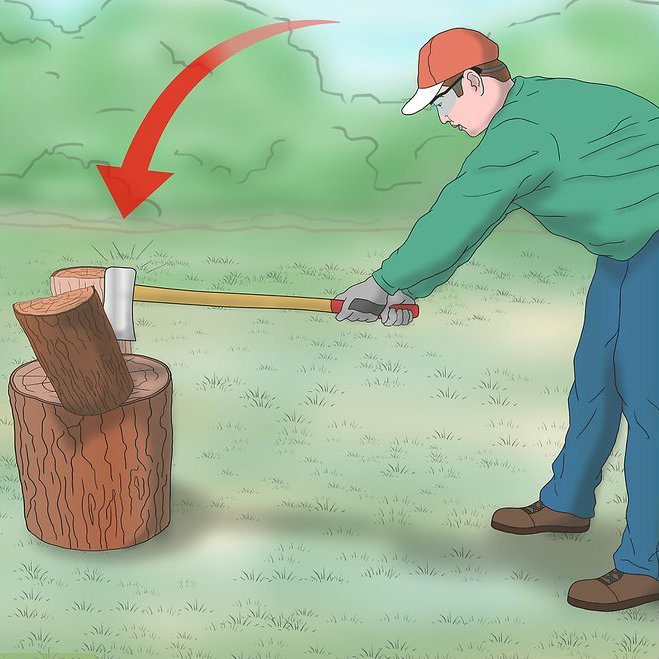

Raise the ax to the side that is more comfortable for you so that you can make a strong and even chopping motion over your shoulder. Grasp the ax as described above, and make sure your stance is stable and your feet are shoulder-width apart. - Another good way is to move the ax from an overhead position - down onto a block that needs to be split.
8. Chopping motion with an ax. Swing down quickly and firmly, letting your dominant hand slide down the ax to your other hand. Look at the right place on the block, which needs to be split before your ax hits that place. - If the tree is very thick or knobby, you may need to hit with the ax several times to split it.
Video how to chop wood without bending over every log
How to chop wood easily and quickly?
There is a little trick that allows you to easily and quickly chop wood. With the usual splitting, the blocks are scattered far from the deck. You have to spend energy on collecting and installing them again on the deck. For the back, the felling process is already very difficult, but here you still have to spend efforts on bends.
It is necessary to take a tire, fix it on a deck and install a block of wood in it. If there is a metal cord on the tire, it must be removed. In case of accidental slipping, the cleaver can get a notch. When a block of wood in the tire is split, the saw cut will not fly off and you can continue to divide it into small parts.
Security measures
Any operations with piercing and cutting tools must be carried out in compliance with the appropriate safety measures:
- Strengthen the ax the day before splitting. Dip it in a bucket of water, the ax will swell, and the cleaver will sit firmly. It is better, of course, to keep it in water for several days. This measure is only applicable for tools with a wooden handle. If the handle is made of metal or plastic, then the operation is useless. We'll have to check the strength of the structure manually.
- If an ax is used, it must be well sharpened. It is necessary to sharpen the ax before each felling.
- Make sure that no one is within a radius of three meters from the deck. Also, do not chop wood close to the windows, a piece of wood may fly off there. An inexperienced woodcutter can leave a lot of empty space around.
- Do not try to split along a knot, the cleaver can either fly off or get stuck tightly.
- Do not wear gloves, they can slip off your hand or change the force of the blow. This threatens injury. Only gloves can be worn.
- When using means of mechanization, keep your hands as far as possible from the cutting tool.
After felling, you need to put the firewood in a woodpile, leaving an air space between them. It is best to stack the woodpile after the entire felling process has been completed. Gradually, chopping wood will become familiar and the speed will increase significantly.
Hydraulic wood splitters
There are three types:
- vertical;
- horizontal;
- mixed.
If you do not know how to properly chop wood with a hydraulic device, then be sure to read the instructions. But one thing is absolutely certain - the efficiency of the unit will depend on the type of model. The domestic version of this device rotates with a hydraulic pump. Operating a hydraulic log splitter is much safer than other options. After all, it works from the network and has several degrees of protection at once.
The wood splitter functions due to gas or liquid that is in the press. The compressed fluid resists the moving surface and brings the entire tool to work. Under high pressure, the machine moves towards the workpiece and splits it into several parts (their number depends on the type of blade). Thus, the logs can be chopped endlessly. All human efforts are reduced to laying firewood and cleaning the work surface.


